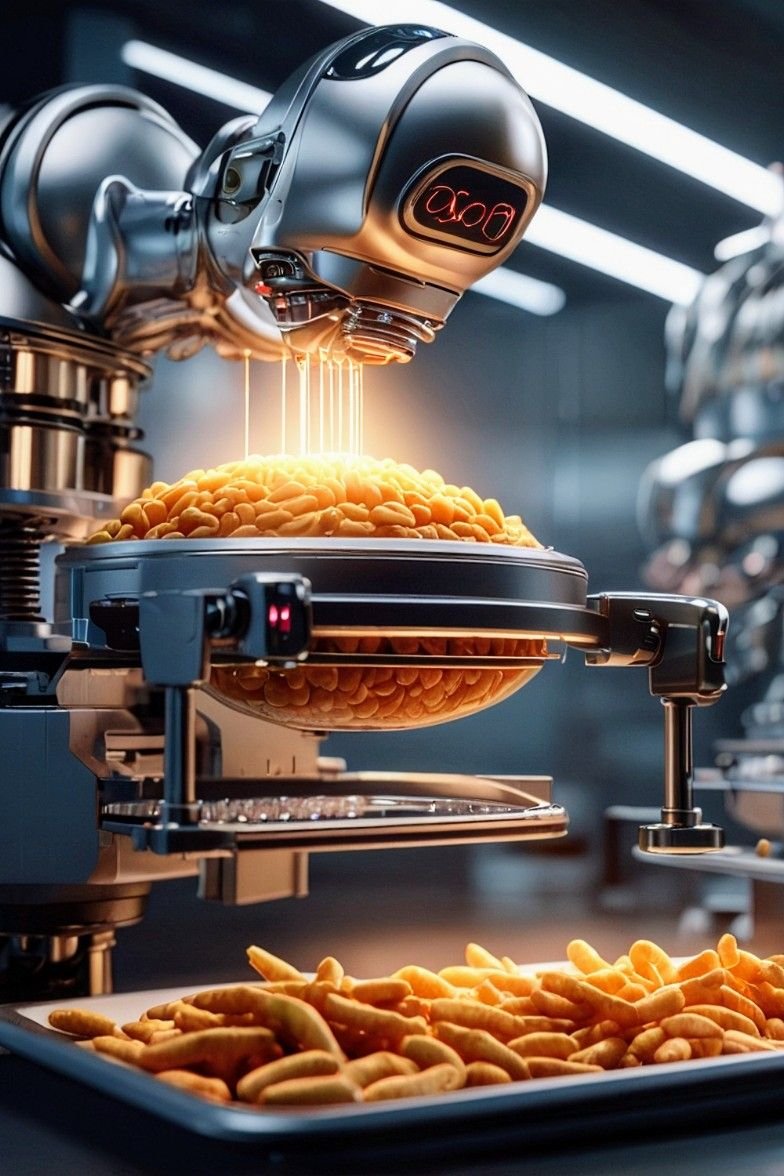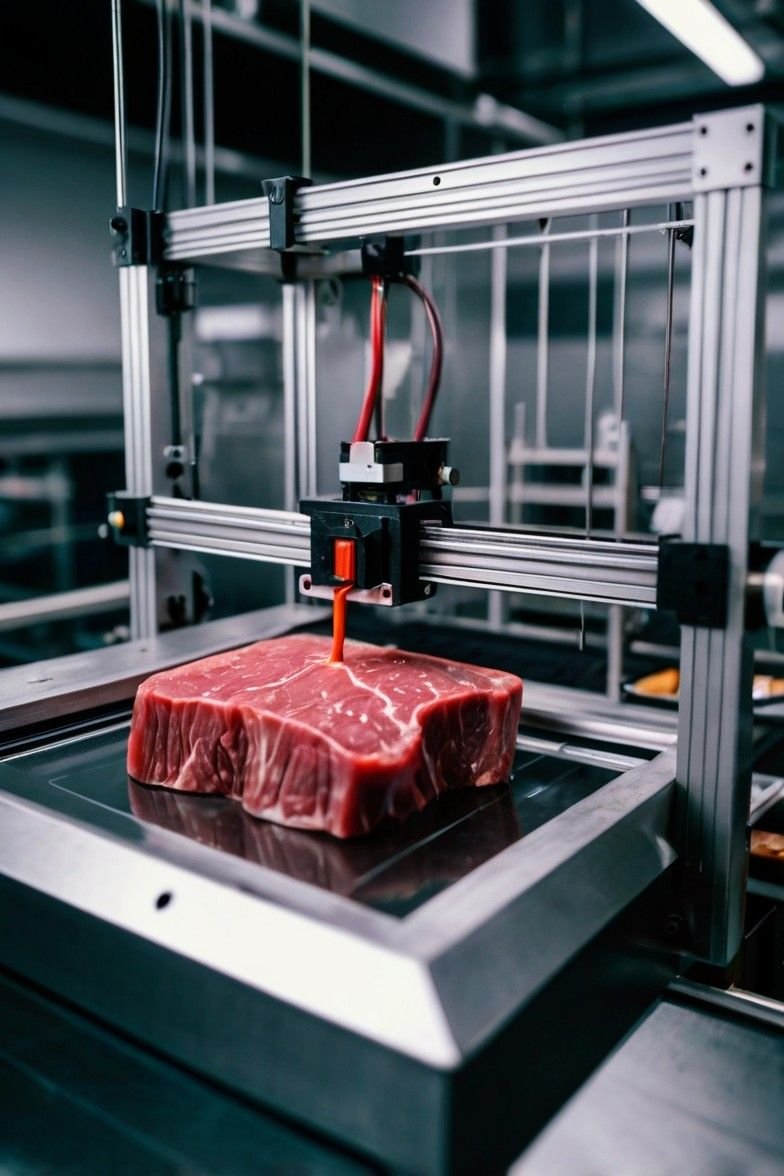AI-Generated Image. What Exactly Is Food Tech? by Tech Is The Culture
Introduction To Food Tech
Food tech, a term that encompasses the application of technology in the food industry, has rapidly gained prominence in recent years. This discipline integrates innovative methodologies and cutting-edge solutions to enhance various processes related to food production, distribution, and consumption. As global challenges such as food security, sustainability, and efficiency become increasingly pressing, food technology emerges as a vital field that addresses these issues through technological advancements.
At its core, food tech aims to transform how food is grown, processed, and consumed by leveraging advancements in areas such as biotechnology, artificial intelligence, and automation. Innovations such as precision agriculture utilize data analysis and sensors to optimize crop yield while minimizing environmental impacts. Similarly, food technology has enabled the creation of alternative proteins and smart food packaging that extends shelf life and reduces waste, showcasing the potential for sustainable practices within the sector.
The significance of food tech in today’s global food system cannot be overstated. As the world population continues to grow, the demand for efficient, safe, and nutritious food sources intensifies. Food technology not only helps in increasing production efficiency but also plays a critical role in improving food safety standards, ensuring that consumers have access to high-quality products. Furthermore, the intersection of technology and food consumption has given rise to meal delivery services and food apps, changing how individuals engage with their diet and enhancing user experience.
Food tech represents a dynamic and impactful sector that fosters innovation across the food industry. By understanding its significance and applications, stakeholders can better appreciate the potential of technology in shaping future food systems. This foundational understanding sets the stage for a closer examination of specific developments and trends in food technology, revealing the multifaceted nature of this essential field.
The Evolution Of Food Tech
The journey of food technology, often referred to as food tech, can be traced back to prehistoric times when early humans began to cultivate crops and domesticate animals. This initial agricultural innovation laid the foundation for the development of civilizations, allowing societies to transition from nomadic lifestyles to settled communities. As a result, food production became more efficient, fostering the growth of population centers.
Fast forward to the 18th century, the Agricultural Revolution introduced significant advancements such as crop rotation and selective breeding, which greatly increased food yields and improved nutritional diversity. The Industrial Revolution brought about mechanization in agriculture, including the invention of the seed drill and the mechanical reaper. These inventions revolutionized food production, making it possible to feed larger populations and paving the way for urbanization.
As the 20th century approached, the introduction of refrigeration, pasteurization, and canning further transformed the food industry. These technological advancements not only extended the shelf life of food products but also improved food safety and hygiene, ultimately leading to a more reliable food supply. In the 1960s, the Green Revolution emerged, marked by the development of high-yield crop varieties and the extensive use of fertilizers and pesticides, significantly boosting global food production.
Today, food tech continues to evolve rapidly, incorporating cutting-edge innovations such as lab-grown meat and vertical farming, which aim to address the challenges of food security and environmental sustainability. Lab grown meat provide a potential solution to reduce the carbon footprint associated with traditional livestock farming, while vertical farming maximizes space efficiency by allowing crops to be grown in urban environments using soil-less techniques and controlled environments.
This historical progression of food technology reflects the ongoing quest for improved food production methods, culminating in advancements that not only meet the increasing global demand for food but also strive for a sustainable future.
Key Players In The Food Tech Industry
The food tech industry has garnered significant attention in recent years, with various players making remarkable contributions to its evolution. Major companies and innovative startups are at the forefront of this revolution, driving advancements in food technology and changing the way we interact with food.
One of the prominent players in this space is Impossible Foods, a company dedicated to creating plant-based alternatives to meat products. By leveraging biotechnology, they successfully replicate the flavors and textures of traditional meat while minimizing environmental impact. Their flagship product, the Impossible Burger, has gained widespread acceptance, reflecting the growing demand for sustainable food options.
Another notable entity is Beyond Meat, which has emerged as a leading competitor in the plant-based protein market. Their successful marketing strategies and partnerships with fast-food chains have positioned them as key innovators in food technology, significantly advancing the reach of vegan and vegetarian alternatives in everyday diets.
Startups like Oatly and EatJust showcase the diverse applications of food technology. Oatly, focused on oat-based products, emphasizes the health and sustainability benefits of their offerings. On the other hand, EatJust is known for its plant-based egg substitutes, highlighting the potential for food tech to enhance nutrition without compromising on taste or texture.
Thought leaders and industry experts also contribute significantly to the food tech landscape. For instance, Bruce Friedrich, the co-founder of The Good Food Institute, advocates for alternatives to animal-based products, emphasizing the necessity of innovation in food to combat climate change. His insights offer valuable perspectives on the importance of adopting new technologies in food production.
As these companies and leaders continue to push the boundaries of what is possible in the food industry, the future of food technology appears bright, with advancements promising to deliver sustainable, efficient, and health-conscious food solutions on a global scale.
Sustainability & Food Tech
The intersection of sustainability and food technology plays a fundamental role in reshaping our food systems for a more environmentally-conscious future. Innovations in food tech are streamlining processes that contribute to a significant reduction in food waste, an issue that plagues many economies around the globe. Through advanced data analytics, companies can now better predict consumer demand, allowing for optimized production processes that align closely with market needs, thereby minimizing overproduction and waste.
Additionally, agricultural advancements have led to improved crop yields, a critical necessity as the global population continues to rise. Technologies such as precision agriculture leverage satellite imaging, drones, and IoT devices to monitor and manage crop health. This enables farmers to use resources more efficiently, applying water, fertilizers, and pesticides only when necessary. Research indicates that these methods can increase productivity by up to 30%, which not only boosts food availability but also lessens the environmental impact of farming practices.
Furthermore, food technology aids in enhancing resource efficiency throughout the supply chain, addressing issues such as energy consumption and packaging waste. For example, companies are developing biodegradable packaging materials that reduce reliance on plastic and lower carbon footprints. Other initiatives focus on creating energy-efficient food processing methods that conserve energy during production.
Ethical food sourcing is another area where food tech shines brightly. Technologies that track and trace food from farm to table empower consumers to make informed choices about the sustainability of their purchases. Notable examples include blockchain solutions that verify the sourcing and sustainability of seafood and organic products, ensuring that ethical standards are met.
Through these multifaceted approaches, food technology is not merely contributing to the economy but is also playing a crucial role in fostering sustainable practices that could lead to a healthier planet.
Health & Nutritions Connection To Tech
The field of food technology plays a pivotal role in shaping health and nutrition by leveraging innovative solutions to address contemporary dietary challenges. One of the significant impacts of food tech is the emergence of mobile applications that assist individuals in making healthier food choices. These apps enable users to track their nutritional intake, scan barcodes for information on food content, and offer personalized meal recommendations based on dietary restrictions and preferences. By utilizing technology, consumers are empowered to make informed decisions that align with their health objectives.
Another promising advancement in the realm of food tech is personalized nutrition, which is grounded in the understanding that dietary needs vary among individuals. Innovations such as genomic testing and artificial intelligence provide tailored dietary plans that consider a person’s genetics, lifestyle choices, and health conditions. This approach goes beyond generalized dietary advice, allowing for a more customized food experience that can optimize health outcomes. As a result, misconceptions surrounding “one size fits all” meal plans are gradually being dispelled, highlighting the importance of individual differences in nutrition.
Food technology is also enhancing food safety, an essential component of public health. Implementing advanced technologies such as blockchain for traceability and monitoring quality control through IoT (Internet of Things) devices ensures the integrity of food supply chains. These innovations address critical safety concerns by allowing stakeholders to trace food products back to their sources quickly, thus mitigating the risks associated with foodborne illnesses. The combination of innovation in food sourcing, tracking, and safety protocols helps instill greater consumer confidence, leading to improved overall health outcomes.
Overall, the intersection of food tech and health is a dynamic and evolving landscape that aims to enhance nutritional quality, ensure safety, and meet individualized dietary needs. The continued advancement in this field is vital to fostering healthier societies and combating nutrition-related issues on both individual and community levels.
The Rise of Alternative Proteins
In recent years, the food industry has witnessed a remarkable transformation with the rise of alternative proteins. Driven by a growing awareness of health, environmental sustainability, and ethical considerations, consumers are increasingly looking for substitutes to traditional meat products. This shift has spurred innovations in food technology, leading to the development of an array of plant-based meats and lab-grown options aimed at replicating the taste and texture of conventional protein sources.
The surge in alternative proteins is significantly influenced by various factors, including climate change, animal welfare concerns, and dietary preferences. As data increasingly suggests a link between meat consumption and environmental impact, more individuals are seeking sustainable options that reduce their ecological footprint. Consequently, businesses in the food tech sector are diligently working to create products that not only meet consumer demands for ethical eating but also mirror the culinary experience associated with traditional meat.
Leading companies are responding to these market trends by investing heavily in research and development. They aim to refine the sensory attributes of alternative proteins, ensuring that taste and texture meet consumer expectations. Advanced food technology techniques such as extrusion and fermentation are being employed to enhance the flavor and mouthfeel of plant-based products, making them appealing not only to vegetarians and vegans but also to omnivores. Moreover, nutritional value is a priority; many companies are fortifying their offerings with essential nutrients typically found in meat.
As the demand for alternative proteins continues to grow, traditional meat production faces potential disruption. This evolving landscape presents challenges and opportunities for both new entrants in food tech and established players. Understanding consumer preferences and leveraging innovative solutions will be key to thriving in this rapidly changing market.
Food Delivery & E-Commerce Innovations
The intersection of technology and food has transformed the landscape of food delivery and e-commerce. In recent years, the rise of meal kit services has particularly illustrated how food technology is reshaping consumer experiences. Companies such as Blue Apron and HelloFresh have emerged, offering pre-portioned ingredients and easy-to-follow recipes delivered directly to consumers’ doorsteps. This innovation addresses the dual challenges of convenience and meal planning, allowing individuals to enjoy homemade meals without extensive preparation.
Moreover, the proliferation of delivery applications such as Uber Eats, DoorDash, and Grubhub has further revolutionized how consumers access food. These platforms enable users to order from a plethora of local restaurants, facilitating a broader variety of dining options than ever before. The seamless integration of these services into everyday life has fundamentally altered consumer behavior, with more individuals opting for delivery due to its convenience and variety. This shift has been dramatically amplified by the COVID-19 pandemic, which accelerated the reliance on such food services as people sought to minimize exposure while enjoying their favorite meals.
The pandemic has also underscored the importance of online grocery shopping. Retailers had to adapt rapidly to meet the surging demand for e-commerce solutions in food markets, leading to advancements in inventory management and logistics. Innovations such as contactless delivery and curbside pickup have become commonplace, with many grocery chains expanding their online presence to enhance customer accessibility. This technological evolution has not only streamlined operations for retailers but also tailored the shopping experience to consumer preferences for safety and convenience.
The advancements in food delivery and e-commerce highlight the significant role of food technology in modern society. This interplay enhances user experience and addresses contemporary challenges while paving the way for future innovations in meal accessibility and convenience.
Challenges Facing the Food Tech Industry
The food tech industry has gained significant traction in recent years; however, it is not without its challenges. One of the primary hurdles is the regulatory landscape, which can be complex and, at times, cumbersome for new food technology innovations. Food products often require stringent testing and compliance with safety standards set by government bodies, which can lead to extended timelines for bringing new solutions to market. This regulatory scrutiny is vital for consumer safety, yet it poses a significant barrier for startups aiming to innovate within the food sector.
Another challenge is consumer acceptance. Despite advancements in food technology, many consumers remain skeptical about the safety and efficacy of new products, particularly when it comes to lab-grown or genetically modified foods. Public perception often lags behind technological capabilities, meaning that even the most promising innovations may struggle to gain traction if they are met with resistance from consumers. Education and transparent communication will be essential in bridging this gap, ensuring that the benefits of food tech are clearly articulated to the public.
Additionally, securing investment can be particularly challenging for food tech startups. Although venture capital interest in the sector has grown, many investors remain cautious, often requiring a proven track record of success before committing funds. Consequently, innovative ideas frequently face difficulties in scaling operations due to insufficient financial backing. Encouragingly, strategic partnerships between food tech companies and established food manufacturers can offer solutions, providing the necessary resources and expertise to navigate both regulatory challenges and consumer acceptance issues.
Addressing these barriers is essential to foster a thriving food tech ecosystem and ensure that advancements not only reach consumers but also contribute positively to the future of food sustainability and safety.
The Future of Food Tech (Trends to Watch)
The landscape of food technology is rapidly evolving, influenced by societal needs, environmental considerations, and technological advancements. As we look towards the future, several key trends are likely to shape the food tech industry over the next decade. One of the most significant trends is the integration of artificial intelligence (AI) in food production and distribution. AI has the potential to optimize supply chain management, predict consumer preferences, and reduce food waste, ultimately leading to more efficient food production processes.
Another emerging trend is the growth of plant-based diets and alternative proteins. As a response to growing health consciousness and environmental concerns, consumers are increasingly exploring meat substitutes made from plants or lab-grown alternatives. Food technology is instrumental in developing these products, ensuring they are not only sustainable but also nutritious and appealing to consumers. This shift in dietary preferences is expected to drive innovation, resulting in a myriad of new products that cater to diverse taste profiles.
Sustainability is also at the forefront of food tech advancements. With climate change posing a significant threat to global food security, technologies that enhance sustainability in agriculture, such as vertical farming and precision agriculture, are gaining traction. These methods promise a more resource-efficient approach to farming, reducing the carbon footprint of food production while ensuring a steady supply of food to meet growing demand.
Moreover, digitalization will continue to play a critical role in food technology. Mobile apps and online platforms are increasingly reshaping how consumers interact with food, from personalized meal plans to grocery shopping and delivery services. The convenience offered by these digital solutions is likely to cultivate a more engaged consumer base, prompting individuals to prefer experiences that marry technology with food.
The future of food tech is set to be dynamic, driven by innovation and changing consumer preferences. As these trends unfold, it is essential for consumers to stay informed and engaged in the food technology landscape, as their choices will significantly influence its direction and development.
Let us know your thoughts on the subject at techistheculture.bsky.social. Keep ahead of the game with our newsletter & the latest tech news.
Disclaimer: This article contains some AI-generated content that may include inaccuracies. Learn more [here].



